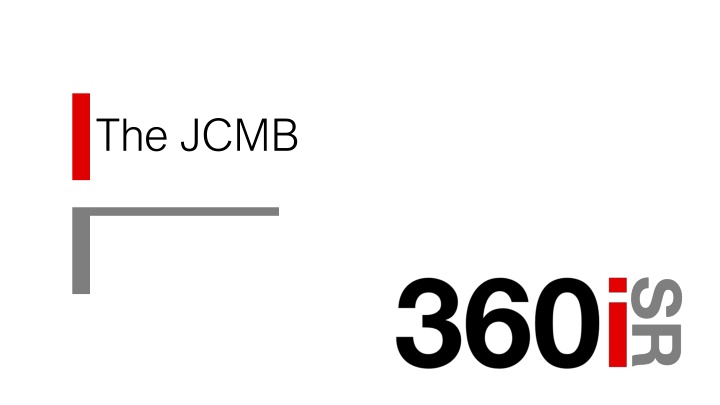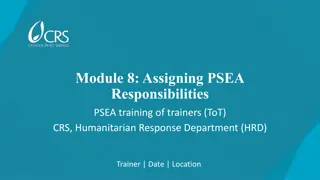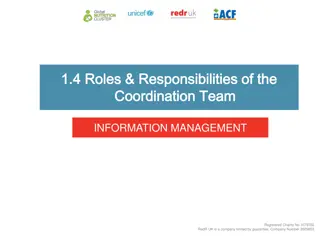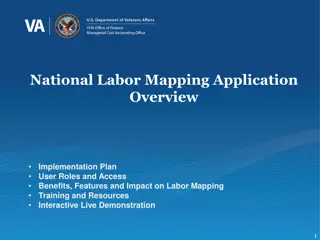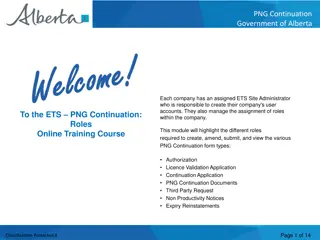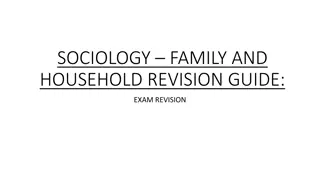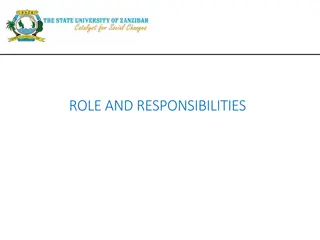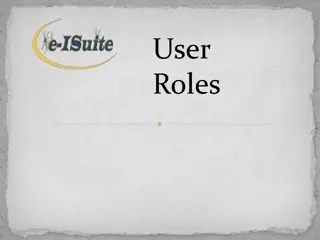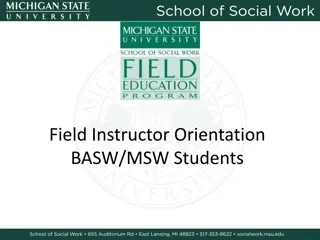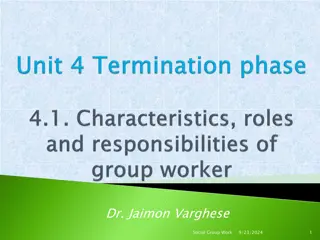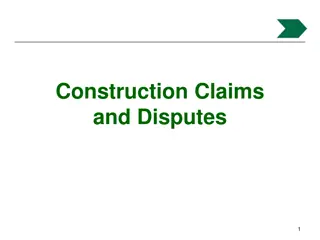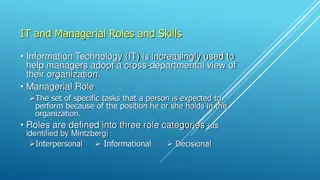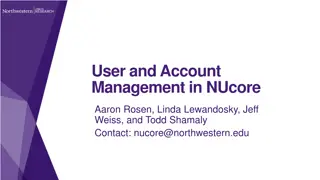JCMB Roles and Responsibilities OverviewT
The JCMB (Joint Collection Management Board) is tasked with reviewing, validating, and prioritizing all JISR CRs and assigned capabilities. This involves coordinating and synchronizing JISR activities between joint-level and subordinate formations, ensuring efficient collection management. The board includes representatives from targeting, operations, warfare, intelligence, and other key areas. Roles involve directing near-future joint CRs, adjusting planning processes, resolving conflicting priorities, and coordinating with ISR operations staff. The JCMB also plays a key role in finalizing D+1 CXP for mission integration and addressing dissemination challenges.
Uploaded on Apr 12, 2025 | 0 Views
Download Presentation

Please find below an Image/Link to download the presentation.
The content on the website is provided AS IS for your information and personal use only. It may not be sold, licensed, or shared on other websites without obtaining consent from the author.If you encounter any issues during the download, it is possible that the publisher has removed the file from their server.
You are allowed to download the files provided on this website for personal or commercial use, subject to the condition that they are used lawfully. All files are the property of their respective owners.
The content on the website is provided AS IS for your information and personal use only. It may not be sold, licensed, or shared on other websites without obtaining consent from the author.
E N D
Presentation Transcript
Scope Define the JCMB Outline the roles and responsibilities of the JCBM Offer a suggested attendee list Suggested agenda
Introduction The overall purpose of the JCMB is to: Review Validate De-conflict and Prioritize all JISR CRs and assigned capabilities. The JCMB is designated as a joint-level collection management board which seeks to prioritize, coordinate and synchronize the JISR activity between the joint level and the subordinate formations (land, maritime, air, and special operations forces [SOF] components).
Attendees The JCMB should include, but is not limited to, representation from: Targeting Current operations Current plans Future plans Electronic warfare IMINT SIGINT HUMINT Psychological operations Information operations Engineers and Civil military interaction.
Timing - Battle Rhythm Considerations. The placement of the JCMB within the joint HQ battle rhythm is affected by numerous considerations which must be synchronized in order to achieve maximum efficiency. These considerations include, but are not limited to: The timings of relevant boards or working groups (e.g. targeting board, intelligence fusion and joint coordination board) which have impacts on collection focus and prioritization. The JCMB must be completed in sufficient time to allow for mission integration of the CTL in accordance with the operations orders production timeline. The subordinate CC timings should be considered in this (e.g. air tasking order (ATO) release time) as well.
Roles and Responsibilities Coordinate and direct near-future joint CRs of the components and joint-level HQ from the draft CTL. Coordinate and adjust D+1, D+2 and D+3 as well as longer-term CTLs taking into account other planning and tasking processes. Discuss ad hoc/dynamic requirements arising outside of the collection request deadlines and the joint-level HQ collection coverage (and gaps). Review status of on-going/upcoming significant operations, targeting changes, and intelligence focus in order to establish the deliberate planning and dynamic collection priorities. Resolve conflicting priorities. Coordinate with ISR operations staff and subordinate commands to meet unfulfilled CRs.
Roles and Responsibilities Coordinate proposed D+1 CXP for approval by JCMB so D+1 CXP can be finalised and promulgated in concert with release of the D+1 ATO/FRAGOs/OPTASK. The JCMB will deliver an approved CXP D+1. Confirm JISR capability status and availability. Address outstanding dissemination shortcomings, outages, and potential mitigation plans. Discuss feedback and assessment issues provided by subordinate formations for JISR missions conducted. Identify additional collection capability requirements to be submitted to higher formations. Validates and approves CTL assigning appropriate component commands to JISR tasks. Finalise D+1 CTL and draft D+2, D+3 CTL.
Inputs to the JCMB Inputs are expected to be submitted by the subordinate components and joint staff elements, include the following: ISRR for D+3 in the format of a CRL. Availability of JISR capabilities, to include exploitation capability. JISR overlay/JISR synchronisation matrix for D+1 and D+2 depicting where and when component s JISR assets are being employed (planned/tasked) within their area of operation. Updated collection priorities.
Outputs of the JCMB To include: Finalized CTL for D+2.17 The CTL will be disseminated daily through two channels: Informally through the TCM to subordinate collection managers. Formally through the operations staff via an approved order (e.g. FRAGO/JCO/OPORD). Updated CTL for D+1, including new ad hoc requirements received in the last 24 hours. Draft CTL for D+3. Record of decisions. Deliver an approved CXP D+1.
A Potential Agenda A potential agenda for a JCMB could include: A potential agenda for a JCMB could include: Consequences of PIR changes and, if necessary, review CRs for changes that could impact planned JISR operations. Review collection priorities. Collection hot topics/issues to include: re-tasking, changes in JISR asset availability, serviceability, forthcoming weather issues. Weather forecast for D+1 and D+2. Review of JISR synchronization matrix for current ATO collection. Review of JISR synchronization matrix for D+1 and D+2; receive ad hoc planning requirements. Release and discuss new JISR synchronization matrix for D+3 (72-96 hours). CC coverage/feedback to include asset locations and status, and any new CRs (D+3) or upcoming operations. JISR assessment and feedback. Direction and guidance; record of decisions.
Again So What What does all of this mean? Why is important?
Review What does it mean? The JCMB Reviews, Validates, De-conflict and Prioritizes all JISR CRs and assigned capabilities. In order to review and validate, the JCMB needs all Joint level and subordinate CRs in the form of a CRL In order to de-conflict the JCMB needs understanding of CCs capability and availability. In order to prioritize the JCMB needs the wieghted CRLs and the updated prioritization matrix
Review JCMB Arbitration The JCMB will arbitrate in the case of conflicting priorities and apportion tasks accordingly In order to do so it need representation from all stakeholders
So what is the JCMB? Simply put, it is the command structure that authorises with collection requirements will be tasked to ISR Units. Therefore, it is very important Even if it sounds over complicated and bureaucratic
Scope Define the JCMB Outline the roles and responsibilities of the JCBM Offer a suggested attendee list Suggested agenda References: AIntP 14 AJP 2.7
